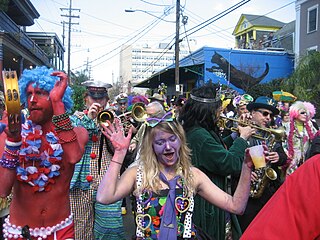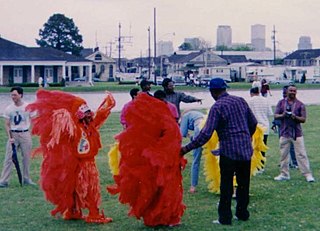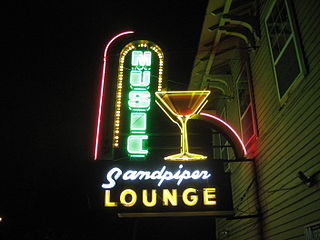
Mardi Gras refers to events of the Carnival celebration, beginning on or after the Christian feasts of the Epiphany and culminating on the day before Ash Wednesday, which is known as Shrove Tuesday. Mardi Gras is French for "Fat Tuesday", reflecting the practice of the last night of eating rich, fatty foods before the ritual Lenten sacrifices and fasting of the Lenten season.

Metairie is a census-designated place (CDP) in Jefferson Parish, Louisiana, United States, and is part of the New Orleans metropolitan area. With a population of 143,507 in 2020, Metairie is the largest community in Jefferson Parish and was the fifth-largest CDP in the United States. It is an unincorporated area that would have been Louisiana's fourth-largest city behind Shreveport if incorporated.

The Mistick Krewe of Comus, founded in 1856, is a New Orleans, Louisiana, Carnival Krewe. It is the oldest continuous organization of New Orleans Mardi Gras festivities.

Rex is a New Orleans Carnival Krewe which stages one of the city's most celebrated parades on Mardi Gras Day. Rex is Latin for "King", and Rex reigns as "The King of Carnival".

The holiday of Mardi Gras is celebrated in southern Louisiana, including the city of New Orleans. Celebrations are concentrated for about two weeks before and through Shrove Tuesday, the day before Ash Wednesday. Mardi Gras is French for Fat Tuesday, but the season actually begins on King’s Day, January 6th, and extends until midnight before Ash Wednesday. Club, or Krewe, balls start soon after, though most are extremely private, with their Kings and Queens coming from wealthy old families and their courts consisting of the season’s debutantes. Most of the high society Krewes do not stage parades. As Fat Tuesday gets nearer, the parades start in earnest. Usually there is one major parade each day ; many days have several large parades. The largest and most elaborate parades take place the last five days of the Mardi Gras season. In the final week, many events occur throughout New Orleans and surrounding communities, including parades and balls.

Mardi Gras Indians are black carnival revelers in New Orleans, Louisiana, who dress up for Mardi Gras in suits influenced by Native American ceremonial apparel.
The Krewe of Endymion is a New Orleans Mardi Gras super krewe and social organization.
Krewe of Tucks is a New Orleans Mardi Gras krewe.

Uptown is a section of New Orleans, Louisiana, United States, on the east bank of the Mississippi River, encompassing a number of neighborhoods between the French Quarter and the Jefferson Parish line. It remains an area of mixed residential and small commercial properties, with a wealth of 19th-century architecture. It includes part or all of Uptown New Orleans Historic District, which is listed on the National Register of Historic Places.

The 12th Ward or Twelfth Ward is a division of the city of New Orleans, Louisiana, one of the 17 Wards of New Orleans. The Ward was formerly part of the old Jefferson City annexed by New Orleans in 1870.
Veterans Memorial Boulevard, formerly Veterans Highway, is a 6-lane thoroughfare in Jefferson Parish, Louisiana, U.S., and Orleans Parish, Louisiana, U.S., running west–east mostly parallel to Interstate 10. The western terminus is at Belleview Boulevard in Kenner just north of the Louis Armstrong New Orleans International Airport and just east of the St. Charles Parish line. Veterans then proceeds in an easterly direction across the Jefferson Parish communities of Kenner and Metairie before crossing the 17th Street Canal into New Orleans and terminating at West End Boulevard approximately 1/2 mile east of the Orleans Parish line.

Mardi Gras in the United States is not observed nationally across the country, largely due to the country's Protestant and Anglo-Saxon roots. Mardi Gras and Carnival are mostly Catholic holidays, while the United States has a Protestant-majority population. However, a number of cities and regions in the U.S. have notable Mardi Gras or Carnival celebrations. Most of these places trace their Mardi Gras celebrations to French, Spanish, and other Catholic colonial influences on the settlements over their history. The earliest Carnival celebration in North America occurred at a place on the west bank of the Mississippi River about 60 miles (97 km) downriver from where New Orleans is today; this Mardi Gras on March 3, 1699, and in honor of this holiday, Pierre Le Moyne, Sieur d'Iberville, a 38-year-old French Canadian, named the spot Point du Mardi Gras near Fort Jackson. The earliest organized Carnival celebrations occurred in Mobile, then the capitol of French Louisiana known as Fort Louis de la Mobile, where in 1704 the first known Carnival secret society. In 1856, six Mobile natives established the first secret society, or krewe, in New Orleans, the Mistick Krewe of Comus. Former French and Spanish colonies such as Pensacola, Biloxi, and settlements along the Gulf Coast all followed suit in incorporating Carnival into their annual celebrations, which today have developed either separate traditions or variations of them from one another. In addition, modern activities generally vary from city to city across the U.S.

The 'Irish Channel Corner Club is the second oldest marching club in New Orleans, La. organized in 1918. It is an all-male carnival organization that marches in parades during Mardi Gras, in which they don colorful custom carnival costumes and specifically design Corner Club beads, and St. Patrick's Day, in which they wear their traditional green vests. Their members walk with canes that have colorful flowers that are given away for kisses while they dance and drink in the streets.

The Intergalactic Krewe of Chewbacchus is a science fiction–themed Mardi Gras krewe, religious and parade organization, that also features fantasy and horror groups, among other fandoms. Based in New Orleans, Louisiana, as of the 2019 parade, the Intergalactic Krewe of Chewbacchus has over 2500 dues-paying members who call themselves "ChewbacchanALIENs" or "Chewbs."
The Mystic Krewe of Nyx is an all-female Krewe organization, based in New Orleans. Organized and founded by Julie Lea in 2011, the Nyx's first pageant, "NOLA Reality Reigns," was featured on the St. Charles Avenue Parade Route on February 15, 2012. The Mystic Krewe of Nyx is named after the Greek goddess of the night, Nyx.

The Krewe of Cleopatra is a New Orleans Mardi Gras Super Krewes and social organization.
Krewe of Thoth is a New Orleans Mardi Gras krewe.
Knights of Chaos is an all-male New Orleans Carnival Krewe and rumored facade for the Knights of Momus.

Freret Street is a street located in uptown New Orleans, Louisiana, United States, that extends from Leake Avenue to the Pontchartrain Expressway. Lying south of the neighborhood of Freret, Freret Street is known for its commercial corridor located between the street's intersection with Jefferson Avenue and Napoleon Avenue. It includes a wide range of restaurants, bars, and other entertainment venues.












